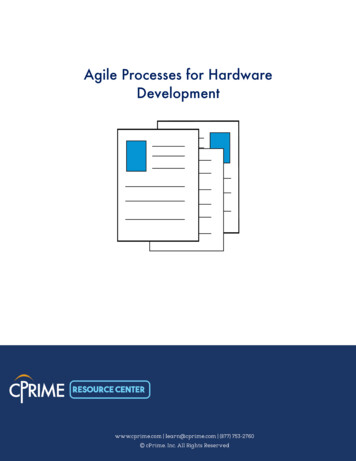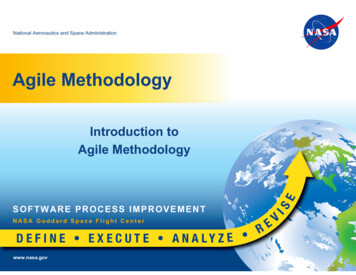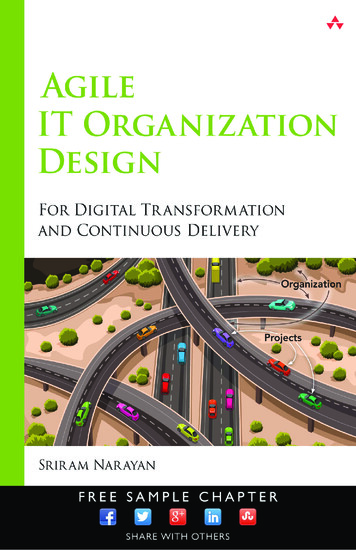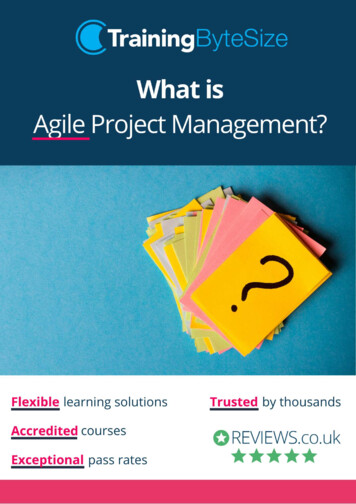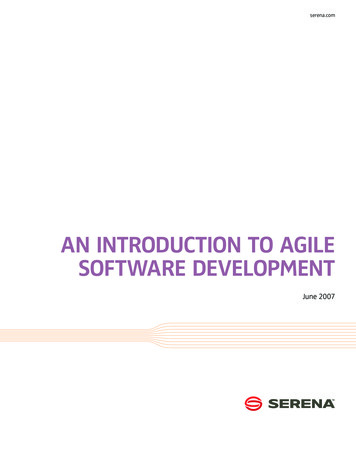
Transcription
serena.comAn Introduction to AgileSoftware DevelopmentJune 2007
Table of ContentsExecutive summary. 3Agile vs. waterfall: practical differences in methodology. 4Two agile software development methodologies. 6XP. 6The XP development process. 6XP rules and concepts.7Scrum. 8Scrum management. 8Scrum development. 8Scrum concepts. 9How Serena supports agile software development. . 10Conclusion. 11 serena.com
Executive summaryAgile software development (also called “agile”) isn’t a set of tools or a single methodology, but a philosophyput to paper in 2001 with an initial 17 signatories. Agile was a significant departure from the heavyweightdocument-driven software development methodologies—such as waterfall—in general use at the time.While the publication of the “Manifesto for Agile Software Development” didn’t start the move to agilemethods, which had been going on for some time, it did signal industry acceptance of agile philosophy. Arecent survey conducted by Dr. Dobb’s Journal shows 41 percent of development projects have now adopted agilemethodology, and agile techniques are being used on 65 percent of such projects.1Manifesto for Agile Software Development2We are uncovering better ways of developing software by doing it andhelping others do it. Through this work we have come to value:Individuals and interactions over processes and toolsWorking software over comprehensive documentationCustomer collaboration over contract negotiationResponding to change over following a planThat is, while there is value in the items on the right,we value the items on the left more.Figure 1. The agile software development manifesto 1Results from Scott Ambler’s March 2006 “Agile Adoption Rate Survey” posted at www.agilemodeling.com/surveys2The Agile Manifesto site includes not only the original 17 framers, but also a large and continually growing list ofsupporters. Additionally, the site includes an overview of agile concepts and viewpoints of the original signatories.Visit http://www.agilemanifesto.org/ to read about the manifesto.serena.com
Agile vs. waterfall: practical differences in methodologyThe first software development methodologies were hardly methodologies at all, but a free-for-all asorganizations struggled to profit from new computer-related technologies. As the industry learned moreabout developing software, certain techniques for managing and predicting the cost of software development projects came into use. The methodology that has dominated software development projects fordecades is called “waterfall.” Winston Royce coined the term in 1970 to describe a serial method for managing software projects through the five stages shown in Figure 2.3Figure 2. The waterfall process for software developmentAdoption of waterfall has helped drive down the failure rate of software development projects, but evenwith rigorous project management and processes, a full 70 percent of software projects using thismethodology fail to meet their objectives. To put this in perspective, waterfall software projects have lessthan half the success rate (66 percent) of going over Niagara Falls in a barrel.Organizations tried to cut the failure rate by insisting on more detail in the requirements and design phases.This process of requiring extensive, even exhaustive, documentation culminated in 1988 with the publicationof the Department of Defense Standard for software development, DOD-STD-2167A.4 3Winston Royce, “Managing the Development of Large Software Systems,” IEEE WESCON, 1970.42167A was replaced by MIL-STD-498 in 1994. While this new standard did give software development organizations more leeway regardingmethodologies, the required deliverables still correspond to stages within waterfall.serena.com
A manifesto for waterfall software development might look like Figure 3.Manifesto for waterfall Software DevelopmentSoftware development can be equated to any other engineering task. Webelieve software development projects can be effectively managed by:Understanding and writing specifications that definehow the software will look and what it will doPerforming in-depth analysis and design workbefore estimating development costsEnsuring software developers follow the specificationsTesting the software after implementation to makesure it works as specified, andDelivering the finished result to the userThat is, if the specification is of sufficient detail, then the softwarewill be written such that it will satisfy the customer, will bewithin budget, and will be delivered on time.Figure 3. A possible waterfall manifestoOne of the most important differences between the agile and waterfall approaches is that waterfall featuresdistinct phases with checkpoints and deliverables at each phase, while agile methods have iterations ratherthan phases. The output of each iteration is working code that can be used to evaluate and respond tochanging and evolving user requirements.Waterfall assumes that it is possible to have perfect understanding of the requirements from the start. Butin software development, stakeholders often don’t know what they want and can’t articulate their requirements.With waterfall, development rarely delivers what the customer wants even if it is what the customer asked for.Agile methodologies embrace iterations. Small teams work together with stakeholders to define quick prototypes, proof of concepts, or other visual means to describe the problem to be solved. The team defines therequirements for the iteration, develops the code, and defines and runs integrated test scripts, and the usersverify the results. (See Figure 4.) Verification occurs much earlier in the development process than it wouldwith waterfall, allowing stakeholders to fine-tune requirements while they’re still relatively easy to change. serena.com
Figure 4. A generic agile development process features an initial planning stage, rapid repeats of the iteration stage, and someform of consolidation before releaseTwo agile software development methodologiesThe most widely used methodologies based on the agile philosophy are XP and Scrum. These differ in particularsbut share the iterative approach described above.XPXP stands for extreme programming. It concentrates on the development rather than managerial aspects of software projects. XP was designed so that organizations would be free to adopt all or part of the methodology.XP developmentXP projects start with a release planning phase, followed by several iterations, each of which concludes withuser acceptance testing. When the product has enough features to satisfy users, the team terminates iterationand releases the software.Users write “user stories” to describe the need the software should fulfill. User stories help the team to estimate the time and resources necessary to build the release and to define user acceptance tests. A user or arepresentative is part of the XP team, so he or she can add detail to requirements as the software is beingbuilt. This allows requirements to evolve as both users and developers define what the product will look like.To create a release plan, the team breaks up the development tasks into iterations. The release plan defineseach iteration plan, which drives the development for that iteration. At the end of an iteration, users performacceptance tests against the user stories. If they find bugs, fixing the bugs becomes a step in the next iteration.Iterative user acceptance testing, in theory, can result in release of the software. If users decide that enoughuser stories have been delivered, the team can choose to terminate the project before all of the originallyplanned user stories have been implemented. serena.com
Figure 5 shows a simplified version of XP. Full XP includes many steps in release planning, iteration, and acceptancetesting that are not shown here. Visit www.extremeprogramming.org for a full description of XP.Figure 5. A simplified XP processXP rules and conceptsThe full list of XP rules and concepts is available at www.extremeprogramming.org/rules.html. Here are themost important concepts:Integrate often. Development teams must integrate changes into the development baseline at least once aday. This concept is also called continuous integration.Project velocity. Velocity is a measure of how much work is getting done on the project. This importantmetric drives release planning and schedule updates.Pair programming. All code for a production release is created by two people working together at a singlecomputer. XP proposes that two coders working together will satisfy user stories at the same rate as twocoders working alone, but with much higher quality.User story. A user story describes problems to be solved by the system being built. These stories must bewritten by the user and should be about three sentences long. User stories do not describe a solution, usetechnical language, or contain traditional requirements-speak, such as “shall” statements. Instead, a sampleuser story might go like this: Search for customers. The user tells the application to search for customers. Theapplication asks the user to specify which customers. After the user specifies the search criteria, the application returns a list of customers meeting those criteria.Because user stories are short and somewhat vague, XP will only work if the customer representative is onhand to review and approve user story implementations. This is one of the main objections to the XP methodology, but also one of its greatest strengths. serena.com
ScrumIn rugby, ‘scrum’ (related to “scrimmage”) is the term for a huddled mass of players engaged with each otherto get a job done. In software development, the job is to put out a release. Scrum for software developmentcame out of the rapid prototyping community because prototypers wanted a methodology that would support an environment in which the requirements were not only incomplete at the start, but also could changerapidly during development.5 Unlike XP, Scrum methodology includes both managerial and developmentprocesses.6,7Scrum managementAt the center of each Scrum project is a backlog of work to be done. This backlog is populated during theplanning phase of a release and defines the scope of the release (see Figure 6).After the team completes the project scope and high-level designs, it divides the development process into aseries of short iterations called sprints. Each sprint aims to implement a fixed number of backlog items (seeFigure 6). Before each sprint, the team members identify the backlog items for the sprint. At the end of asprint, the team reviews the sprint to articulate lessons learned and check progress.During a sprint, the team has a daily meeting called a scrum. Each team member describes the work to bedone that day, progress from the day before, and any blocks that must be cleared. To keep the meetingsshort, the scrum is supposed to be conducted with everyone in the same room—standing up for the wholemeeting.When enough of the backlog has been implemented so that the end users believe the release is worth putting into production, management closes development. The team then performs integration testing, training,and documentation as necessary for product release.Scrum developmentThe Scrum development process concentrates on managing sprints. Before each sprint begins, the teamplans the sprint, identifying the backlog items and assigning teams to these items. Teams develop, wrap,review, and adjust each of the backlog items (See Figure 6).During development, the team determines the changes necessary to implement a backlog item. The teamthen writes the code, tests it, and documents the changes. During wrap, the team creates the executablenecessary to demonstrate the changes. In review, the team demonstrates the new features, adds newbacklog items, and assesses risk. Finally, the team consolidates data from the review to update the changesas necessary. 5Scrum management methodology actually originated earlier in the manufacturing community and was adopted and adapted by softwaredevelopers.6Some development organizations have combined Scrum managerial processes with XP development processes. The adoption rate is still rather low,but growing.7See www.scrumalliance.org for more information about Scrum.serena.com
Following each sprint, the entire team—including management, users, and other interested parties—demonstrates progress from the sprint and reviews the backlog progress. The team then reviews the remainingbacklog and adds, removes, or reprioritizes items as necessary to account for new information and understandinggathered during the sprint.8Figure 6: The Scrum processScrum conceptsFor more detailed information on Scrum, refer to one of the many books on the topic, visit www.scrumalliance.org,or visit wikipedia. Here are a few of the most important concepts:Burndown chart. This chart, updated every day, shows the work remaining within the sprint. The burndownchart is used both to track sprint progress and to decide when items must be removed from the sprint backlog and deferred to the next sprint.Product backlog. Product backlog is the complete list of requirements—including bugs, enhancementrequests, and usability and performance improvements—that are not currently in the product release.ScrumMaster. The ScrumMaster is the person responsible for managing the Scrum project. Sometimes itrefers to a person who has become certified as a ScrumMaster by taking ScrumMaster training.Sprint backlog. Sprint backlog is the list of backlog items assigned to a sprint, but not yet completed. Incommon practice, no sprint backlog item should take more than two days to complete. The sprint backloghelps the team predict the level of effort required to complete a sprint.8 Some Scrum process definitions include sprint planning within the sprint review. Others cite these as distinct meetings.serena.com
How Serena supports agile software developmentThe fast-paced development and cross-silo coordination necessary for a successful agile project requireorganizations to visualize the scope of the project and the project schedule, orchestrate the integration andtesting process, and enforce adherence to agile processes.Visualization helps development organizations to understand the project schedule and see the scope bothof the entire project and of each iteration within the project. Serena Mariner helps teams visualize the availableresources to make sure they have the time, money, and personnel to complete the project. Additionally,Mariner helps teams organize iteration or sprint plans to manage and schedule software releases. SerenaTeamTrack also helps teams stay aware of the scope of an agile project by keeping track of user stories withinXP, managing project and sprint backlogs within Scrum, or tracking tasks for other methodologies.The high-speed development schedule of agile methodologies works best when coupled with automatedprocesses that orchestrate some of the more mechanical development tasks. For example, within both XPand Scrum, development teams must integrate their code into the project baseline often. Each integrationevent involves complete builds of the project baseline as well as automated testing to validate the new code.Automation supports successful continuous integration policies. Depending on the size of the organization andthe complexity of its development processes, either the Serena PVCS Professional suite or Serena Dimensions CM can provide process automation such as continuous integration builds.Agile development isn’t a managerial free-for-all. It requires discipline and adherence to processes, evenwhen those processes are not burdensome. For example, users must review and approve changes beforethey are merged into the baseline, developers must review each other’s code, and code must undergo unittests. These processes act as checks and balances to give greater freedom to development organizationswithin a light-handed enforcement framework. Serena TeamTrack can help the development organization toenforce these agile processes.10serena.com
serena.comConclusionAgile software development stresses rapid iterations, small and frequent releases, and evolving requirementsfacilitated by direct user involvement in the development process. Serena’s application lifecycle managementtools provide a framework to visualize scope, orchestrate mundane and repetitive development tasks, andenforce process. Unlike agile-specific products offered by agile-only vendors, Serena products are methodologyneutral and can be applied equally well to agile as well as more traditional serial development processes, sothey can support all the development activities within an enterprise.ABOUT SERENASerena is the leader in Application Lifecycle Management for distributed and mainframe systems. More than15,000 organizations around the world, including 96 of the Fortune 100, rely on Serena software to automatethe application development process and effectively manage their IT portfolios. For more information onSerena software and services, visit: www.serena.comCONTACTLearn more about the enterprise-wide power of Serena products by visiting http://www.serena.com orcontacting one of our sales representatives in your area.Serena Worldwide HeadquartersSerena Software, Inc.Corporate Offices2755 Campus DriveThird FloorSan Mateo, California 94403-2538United StatesSerena European HeadquartersSerena Software Europe Ltd.Abbey View Everard CloseSt. AlbansHertfordshire AL1 2PSUnited KingdomSerena Asia Pacific Headquarters360 Orchard Road#12-10International BuildingSingapore 238869800.457.3736 T650.522.6699 Finfo@serena.com 44 (0)800.328.0243 T 44 (0)1727.869.804 Fukinfo@serena.com 65 6834.9880 T 65 6836.3119 Fapinfo@serena.comCopyright 2007 Serena Software, Inc. All rights reserved. Serena, Mariner, TeamTrack, Dimensions, and PVCS are registered trademarks and Professional is a trademark ofSerena Software. All other product or company names are used for identification purposes only, and may be trademarks of their respective owners. June07
Agile software development (also called “agile”) isn’t a set of tools or a single methodology, but a philosophy put to paper in 2001 with an initial 17 signatories. Agile was a significant departure from the heavyweight document-driven software development me




